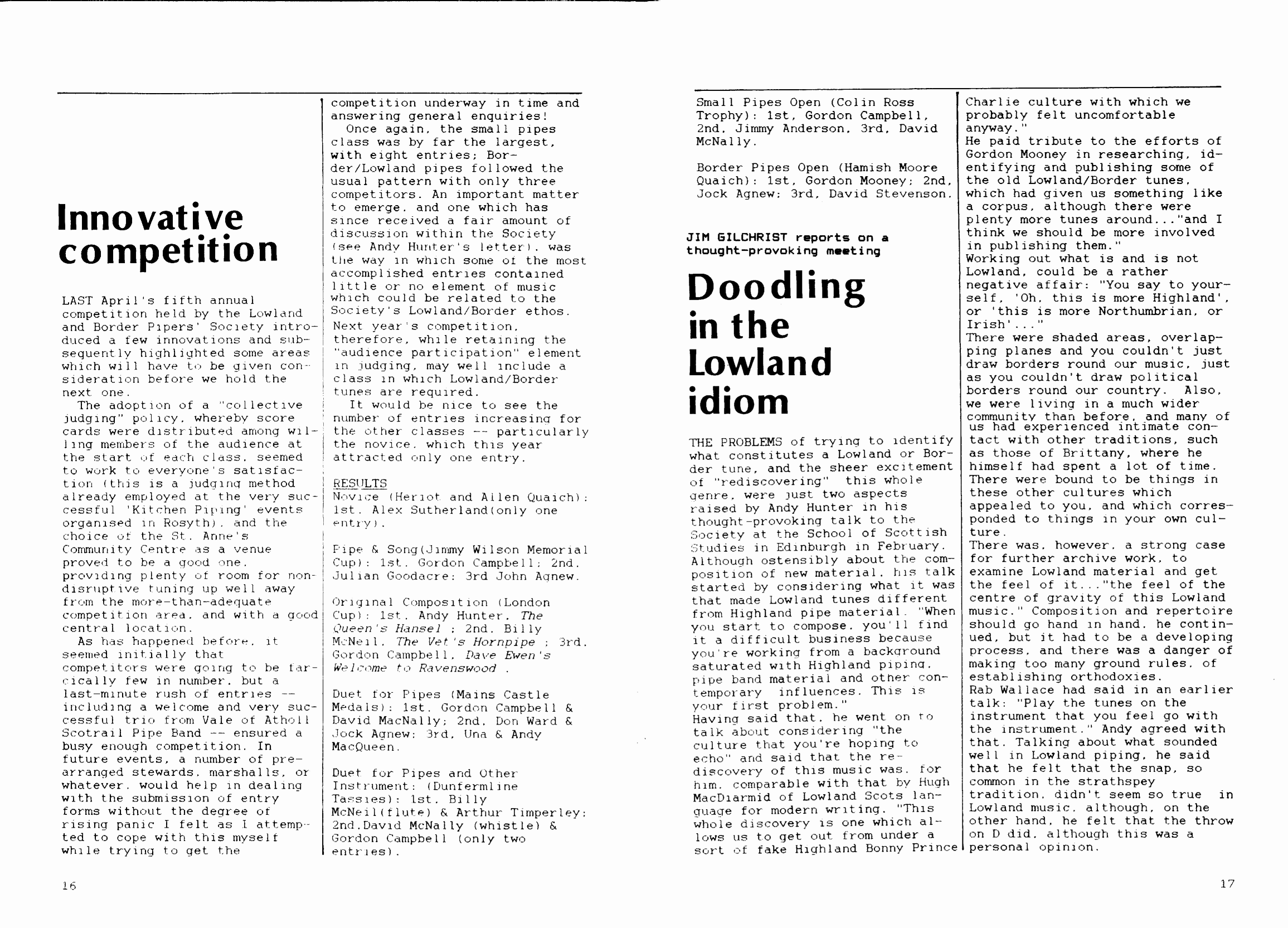Doodling In The Lowland Idiom


JIM GILCHRIST reports on a thought-provoking meeting:
THE PROBLEMS of trying to identify what constitutes a Lowland or Border tune, and the sheer excitement of “rediscovering' this whole genre, were just two aspects raised by Andy Hunter in his thought -provoking talk to the Society at the School of Scottish studies in Edinburgh in February. Although ostensibly about the composition of new material, his talk started by considering what it was that made Lowland tunes different from Highland pipe material.
"When you start to compose. you'll find it a difficult business because you're working from a background saturated with Highland piping. pipe band material and other contemporary influences. This is your first problem."
Having said that, he went on to talk about considering "the culture that you're hoping to echo" and said that the rediscovery of this music was, for him, comparable with that by Hugh MacDiarmid of Lowland Scots language for modern writing. "This whole discovery is one which allows us to get out
from under a sort of fake Highland Bonny Prince Charlie culture with which we probably felt uncomfortable with anyway".
He paid tribute to the efforts of Gordon Mooney in researching, identifying and publishing some of the old Lowland/Border tunes, which had given us something like a corpus, although there were plenty more tunes around..."and I think we should be more involved in publishing them."
Working out what is and is not Lowland, could be a rather negative affair: "You say to yourself, ‘Oh. this is more Highland’. or ‘this is more Northumbrian, or Irish'..."
There were shaded areas, overlapping planes and you couldn't just draw borders round our music, just as you couldn't draw political borders round our country. Also, we were living in a much wider community than before, and many of us had experienced intimate contact with other traditions, such as those of Brittany, where he himself had spent a lot of time.
There were bound to be things in these other cultures which appealed to you, and which corresponded to things in your own culture. There was, however, a strong case for further archive work, to examine Lowland material and get the feel of it..."the feel of the centre of gravity of this Lowland music." Composition and repertoire should go hand in hand. he continued, but it had to be a developing process. and there was a danger of making too many ground rules, of establishing orthodoxies.
Rab Wallace had said in an earlier talk: "Play the tunes on the instrument that you feel go with the instrument." Andy agreed with that. Talking about what sounded well in Lowland piping. he said that he felt that the snap, so common in the strathspey tradition, didn't seem so true Lowland music, although, on the other hand, he felt that the throw on D did, although this was a personal opinion.
“It's probably more a case of adopting the more open time- signatures like the 4/4 Marches and reels- and I don't see why we shouldn't hijack 9/8 time as well as investigating some of the old tunes that Gordon has found.
"But I think the real test will come with the slow airs. They demand a tremendous amount of expression to be successful.”
Getting on to the process of composition itself, he said that, having started composing, he had got so involved that it was becoming a bit of a nuisance..."I’m finding that I can't take my pipes out of the case and start playing, but 1 find myself doodling on something else!”
And composition, as he found it, was indeed a ‘doodling' process on the pipe chanter. He used a tape recorder, which he found invaluable. The only thing was that, in his excitement in wanting to get new ideas down on tape, he found himself forgetting all about bellows control and fingering... the results or which became all too evident when he played back the tape! There was also the transcribing your efforts: “I’ve filled about three C90 tapes,
with not a single tune transcribed yet...
